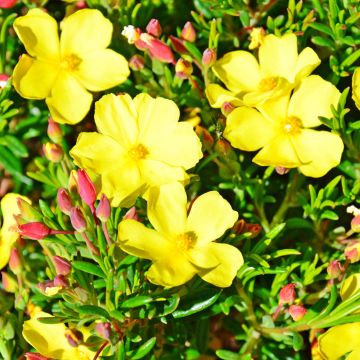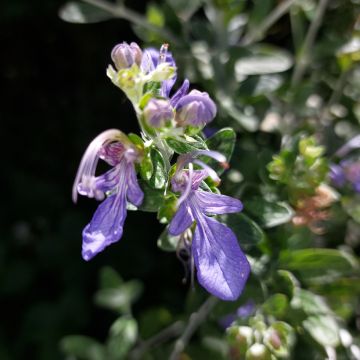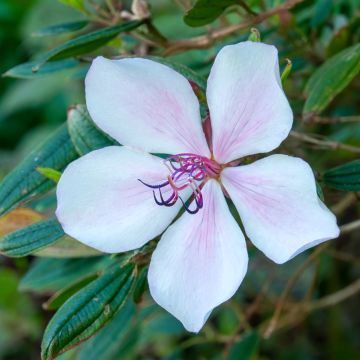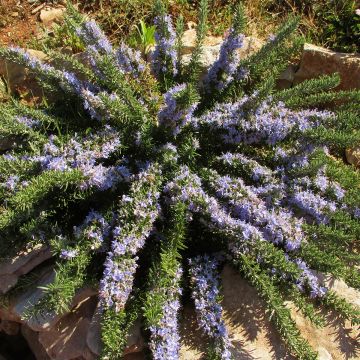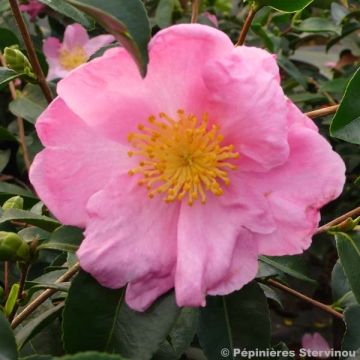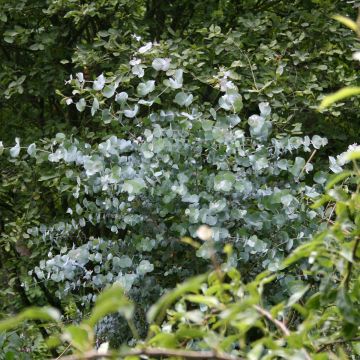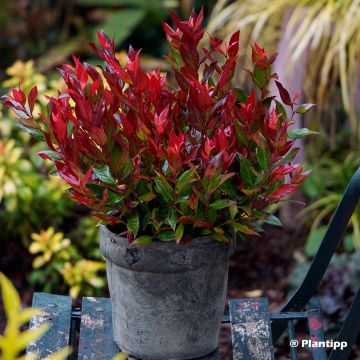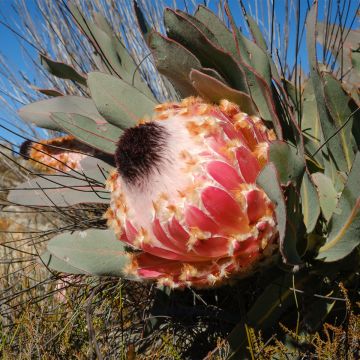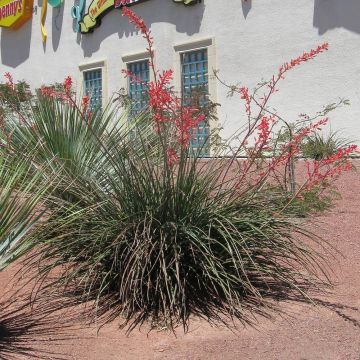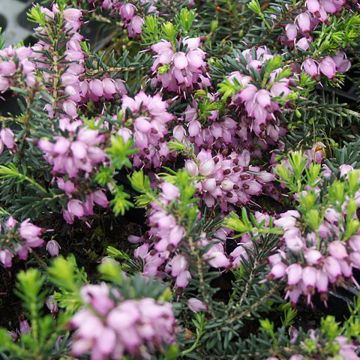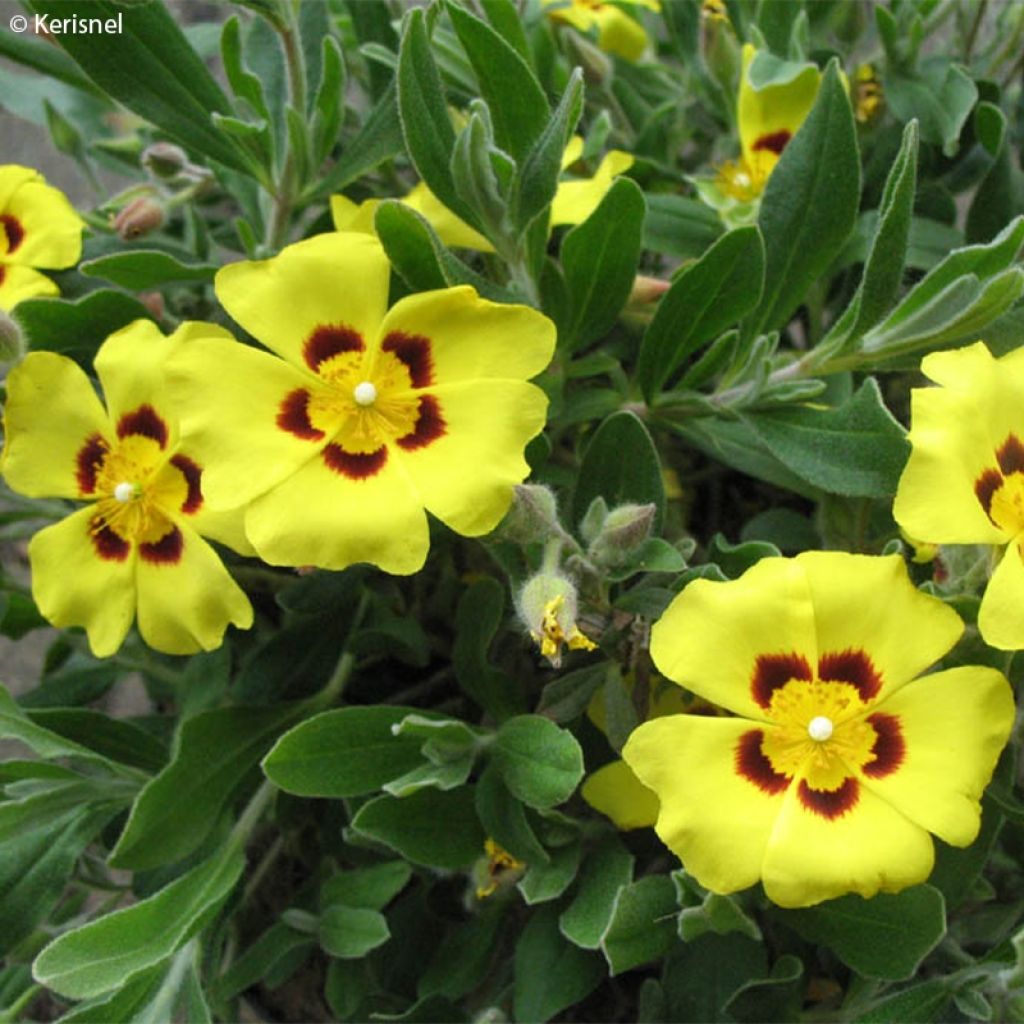

Halimium lasianthum subsp. Formosum
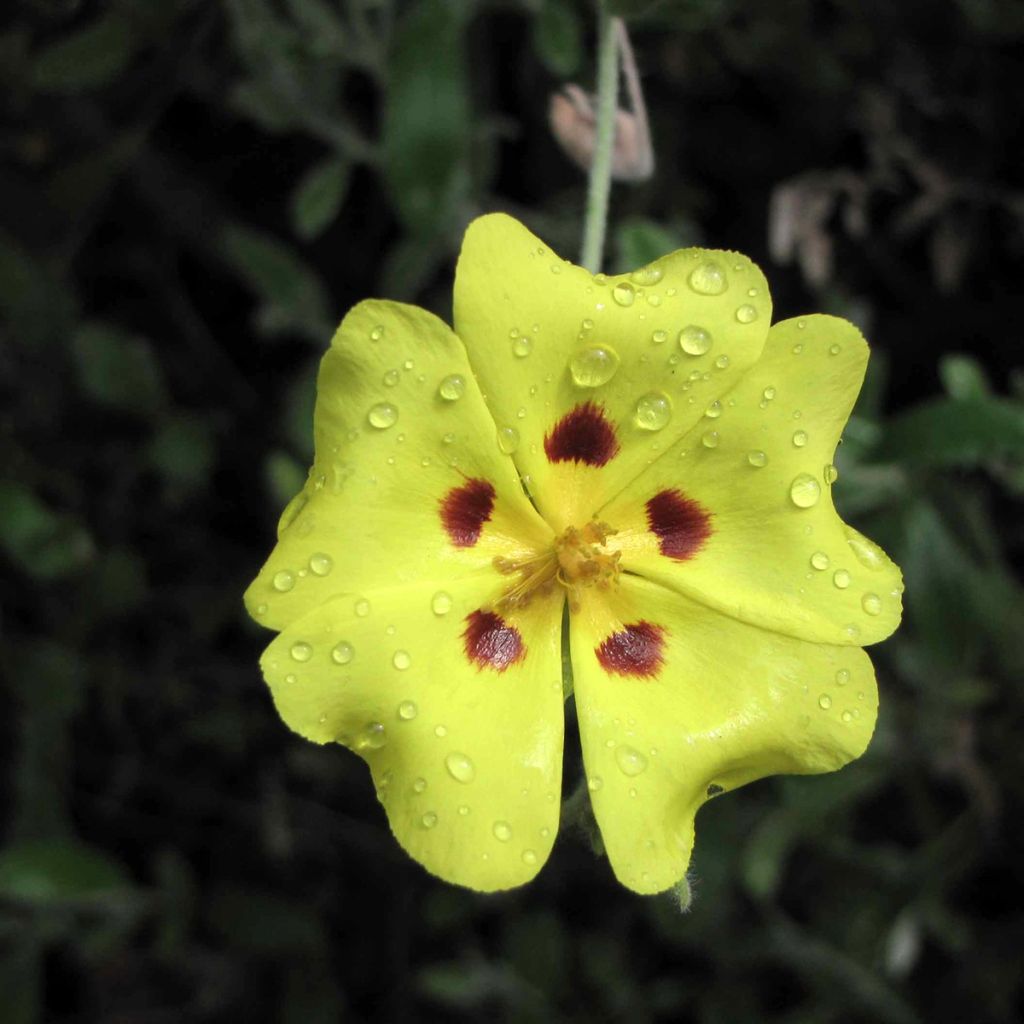

Halimium lasianthum subsp. Formosum
Halimium lasianthum subsp. formosum
Halimium lasianthum subsp. formosum
Rock Rose
This plant carries a 24 months recovery warranty
More information
We guarantee the quality of our plants for a full growing cycle, and will replace at our expense any plant that fails to recover under normal climatic and planting conditions.
From €5.90 for pickup delivery and €6.90 for home delivery
Express home delivery from €8.90.
Does this plant fit my garden?
Set up your Plantfit profile →
Description
Halimium lasianthum subsp. formosum is an evergreen undershrub of Mediterranean origin well adapted to poor and dry soils, just like the cistus and helianthems to which it is closely related. Forming a rounded and spreading bush, it bears pretty small dark grey-green leaves and offers spring to summer flowering that is absolutely radiant, resembling bright yellow dog roses speckled with reddish-brown at the centre. Halimiums are all excellent shrubs for rockeries and dry slopes and charming subjects for decorating sunny terraces, including those by the sea. They can be grown in any well-drained soil without excess lime, in full sun, with almost no water or fertilizer.
Halimium formosum is also called Cistus lasianthus subsp. formosum according to certain nomenclatures. It is an undershrub of the Cistaceae family, which is found in the wild in open pine forests and scrub vegetation in southern Spain and Portugal, as well as in northern Morocco. This species can withstand occasional frosts of -12 °C (10.4 °F) in perfectly drained soil. The plant reaches an average height of 60 cm (23.6 in) with a spread of 1 m (3 ft 4 in), displaying a compact slightly prostrate habit that is kept dense through regular light pruning.
The flowering occurs before the height of summer, from April to June-July depending on the climate and soil. At the tips of the branches, floral buds appear in clusters that open into beautiful single flowers measuring 4-5 cm (1.6-2 in) in diameter, with 5 petals of a very bright yellow speckled with very dark red at the base. The heart of the flower is occupied by a bunch of yellow-orange stamens. Each flower disappears in the late afternoon, releasing a shower of petals on the ground. The numerous buds ensure a long flowering period. The leaves are evergreen, ranging from 0.5 to 4 cm (0.2 to 1.6 in) in length, with 3 veins. Downy when they emerge, they turn a fairly dark grey-green when mature, with a silvery downy underside. The root system of this "cistus" is both deep and branching, so powerful that it manages to penetrate between fractured rocks or in dry sand to draw the slightest trace of moisture from deep down, while its surface roots capture moisture from the soil. Its lifespan in the garden varies between 12 and 15 years. This plant is sensitive to root asphyxiation in overly compact and moist soil in winter.
Halimium lasianthum subsp. formosum is an excellent rockery and poor soil plant, perfectly adapted to summer drought. It can create a beautiful scene when combined with Mediterranean bindweeds like Convolvulus sabatius, althaeoides, and cneorum. Create a border, reminiscent of the scrub vegetation, by mixing the foliage and scents of lavenders (blue, white, pink), rosemary (creeping or erect), thymes (T.vulgaris, T. polytrichus), sages (Salvia x jamensis or officinalis), oreganos, teucriums (T.chamaedrys, T. x lucidrys, T. hircanicum), catmints, ballotes, and dryland spurges (E.characias, E. cyparissias). Cultivation in large pots is possible, by ensuring good drainage and providing ample but infrequent watering, allowing the substrate to dry out between waterings.
Report an error about the product description
Halimium lasianthum subsp. formosum in pictures


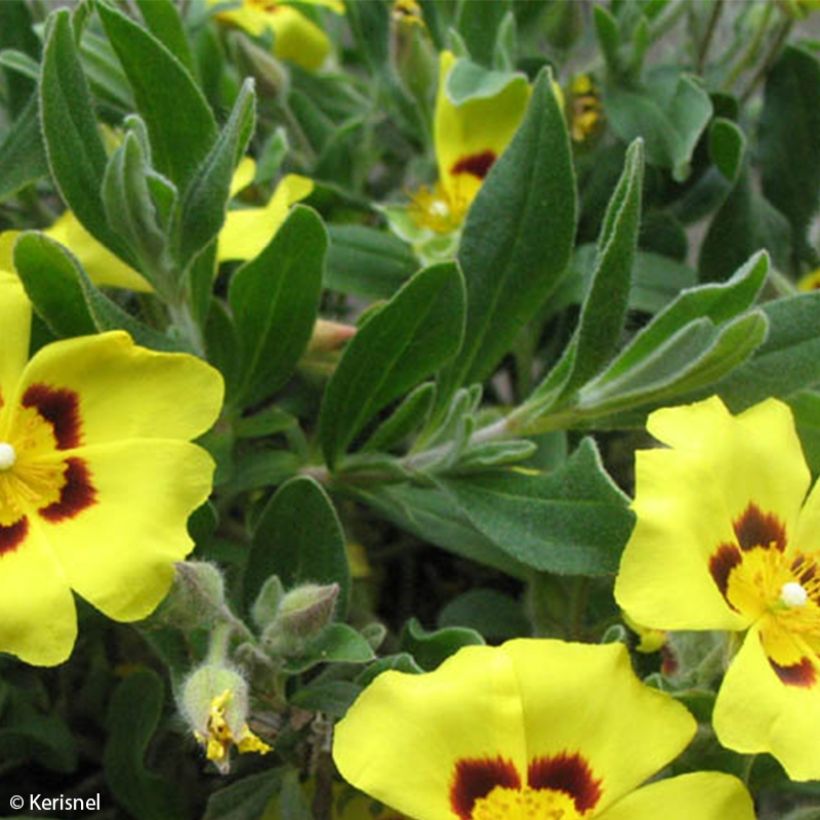

Plant habit
Flowering
Foliage
Botanical data
Halimium
lasianthum subsp. formosum
Cistaceae
Rock Rose
Mediterranean
Other Halimium
Planting and care
Halimium lasianthum formosum requires perfectly drained, rocky or sandy, poor, acidic, neutral or even slightly chalky soil. Plant it after the last frost in the north and in September-October in hot and dry climates. It appreciates the sun, but tolerates partial shade quite well in very sunny climates. It dislikes icy winds that can destroy its flower buds. Under these conditions, a mature plant is hardy down to -12°C (10.4 °F) and will live longer. Mulch it in winter in the coldest regions and protect it from the cold as much as possible. Place it in the warmest corner of the garden, in full sun against a south-facing wall, on a rocky or sandy slope or any substrate that does not retain moisture which would be fatal to it in winter or summer. The combination of heat and excessive humidity can lead to the development of a fungus that attacks the plant's collar and will be fatal to it as much as a Siberian cold. You can lightly prune the stems after flowering to encourage the plant to branch out. Avoid severe pruning.
Planting period
Intended location
Care
This item has not been reviewed yet - be the first to leave a review about it.
Evergreen shrubs
Haven't found what you were looking for?
Hardiness is the lowest winter temperature a plant can endure without suffering serious damage or even dying. However, hardiness is affected by location (a sheltered area, such as a patio), protection (winter cover) and soil type (hardiness is improved by well-drained soil).

Photo Sharing Terms & Conditions
In order to encourage gardeners to interact and share their experiences, Promesse de fleurs offers various media enabling content to be uploaded onto its Site - in particular via the ‘Photo sharing’ module.
The User agrees to refrain from:
- Posting any content that is illegal, prejudicial, insulting, racist, inciteful to hatred, revisionist, contrary to public decency, that infringes on privacy or on the privacy rights of third parties, in particular the publicity rights of persons and goods, intellectual property rights, or the right to privacy.
- Submitting content on behalf of a third party;
- Impersonate the identity of a third party and/or publish any personal information about a third party;
In general, the User undertakes to refrain from any unethical behaviour.
All Content (in particular text, comments, files, images, photos, videos, creative works, etc.), which may be subject to property or intellectual property rights, image or other private rights, shall remain the property of the User, subject to the limited rights granted by the terms of the licence granted by Promesse de fleurs as stated below. Users are at liberty to publish or not to publish such Content on the Site, notably via the ‘Photo Sharing’ facility, and accept that this Content shall be made public and freely accessible, notably on the Internet.
Users further acknowledge, undertake to have ,and guarantee that they hold all necessary rights and permissions to publish such material on the Site, in particular with regard to the legislation in force pertaining to any privacy, property, intellectual property, image, or contractual rights, or rights of any other nature. By publishing such Content on the Site, Users acknowledge accepting full liability as publishers of the Content within the meaning of the law, and grant Promesse de fleurs, free of charge, an inclusive, worldwide licence for the said Content for the entire duration of its publication, including all reproduction, representation, up/downloading, displaying, performing, transmission, and storage rights.
Users also grant permission for their name to be linked to the Content and accept that this link may not always be made available.
By engaging in posting material, Users consent to their Content becoming automatically accessible on the Internet, in particular on other sites and/or blogs and/or web pages of the Promesse de fleurs site, including in particular social pages and the Promesse de fleurs catalogue.
Users may secure the removal of entrusted content free of charge by issuing a simple request via our contact form.
The flowering period indicated on our website applies to countries and regions located in USDA zone 8 (France, the United Kingdom, Ireland, the Netherlands, etc.)
It will vary according to where you live:
- In zones 9 to 10 (Italy, Spain, Greece, etc.), flowering will occur about 2 to 4 weeks earlier.
- In zones 6 to 7 (Germany, Poland, Slovenia, and lower mountainous regions), flowering will be delayed by 2 to 3 weeks.
- In zone 5 (Central Europe, Scandinavia), blooming will be delayed by 3 to 5 weeks.
In temperate climates, pruning of spring-flowering shrubs (forsythia, spireas, etc.) should be done just after flowering.
Pruning of summer-flowering shrubs (Indian Lilac, Perovskia, etc.) can be done in winter or spring.
In cold regions as well as with frost-sensitive plants, avoid pruning too early when severe frosts may still occur.
The planting period indicated on our website applies to countries and regions located in USDA zone 8 (France, United Kingdom, Ireland, Netherlands).
It will vary according to where you live:
- In Mediterranean zones (Marseille, Madrid, Milan, etc.), autumn and winter are the best planting periods.
- In continental zones (Strasbourg, Munich, Vienna, etc.), delay planting by 2 to 3 weeks in spring and bring it forward by 2 to 4 weeks in autumn.
- In mountainous regions (the Alps, Pyrenees, Carpathians, etc.), it is best to plant in late spring (May-June) or late summer (August-September).
The harvesting period indicated on our website applies to countries and regions in USDA zone 8 (France, England, Ireland, the Netherlands).
In colder areas (Scandinavia, Poland, Austria...) fruit and vegetable harvests are likely to be delayed by 3-4 weeks.
In warmer areas (Italy, Spain, Greece, etc.), harvesting will probably take place earlier, depending on weather conditions.
The sowing periods indicated on our website apply to countries and regions within USDA Zone 8 (France, UK, Ireland, Netherlands).
In colder areas (Scandinavia, Poland, Austria...), delay any outdoor sowing by 3-4 weeks, or sow under glass.
In warmer climes (Italy, Spain, Greece, etc.), bring outdoor sowing forward by a few weeks.

































